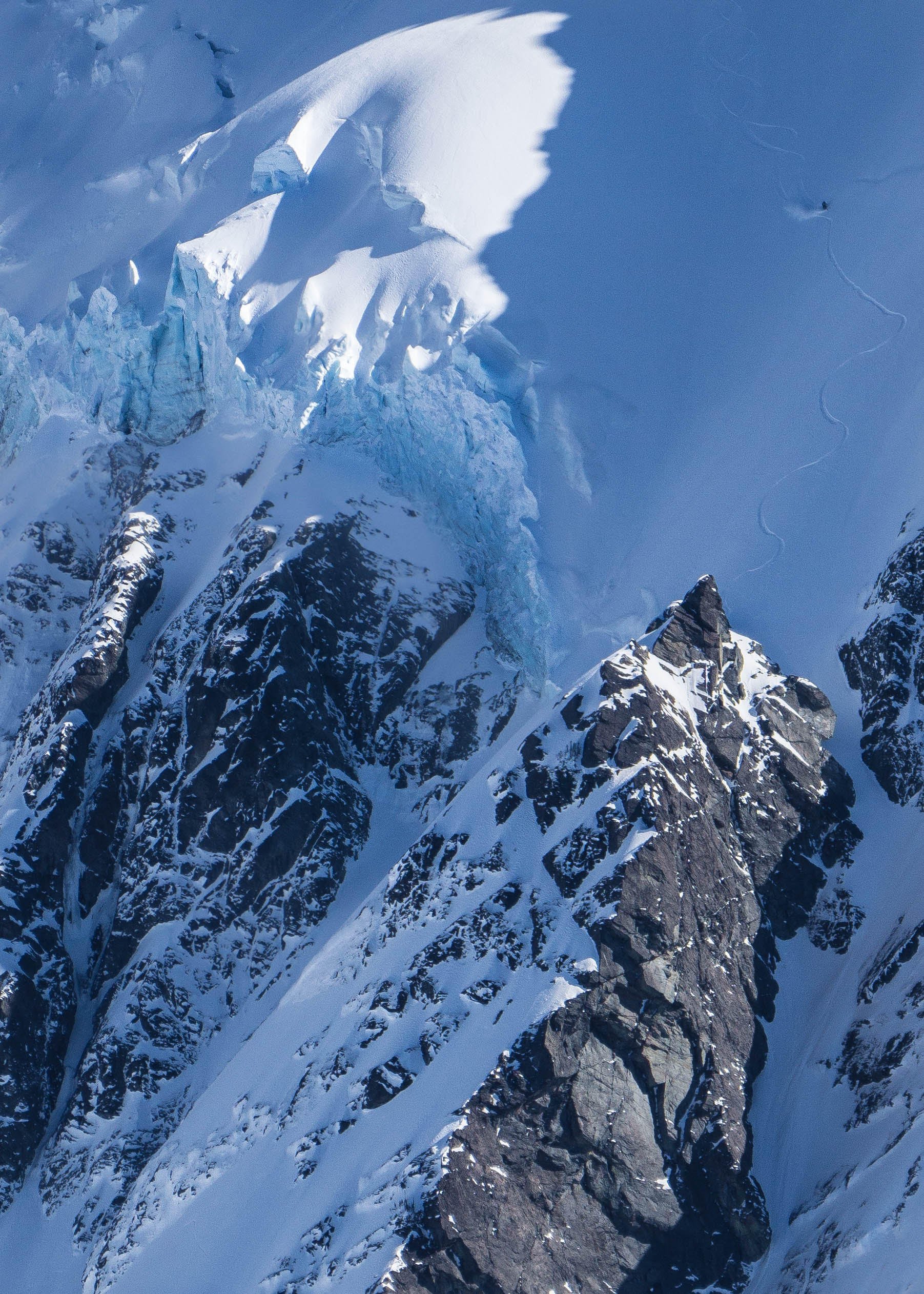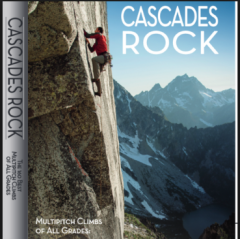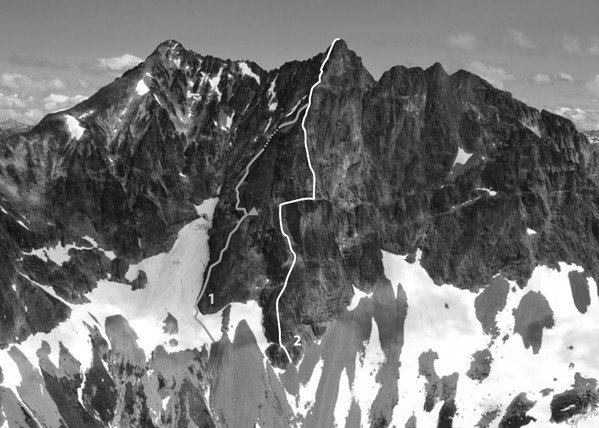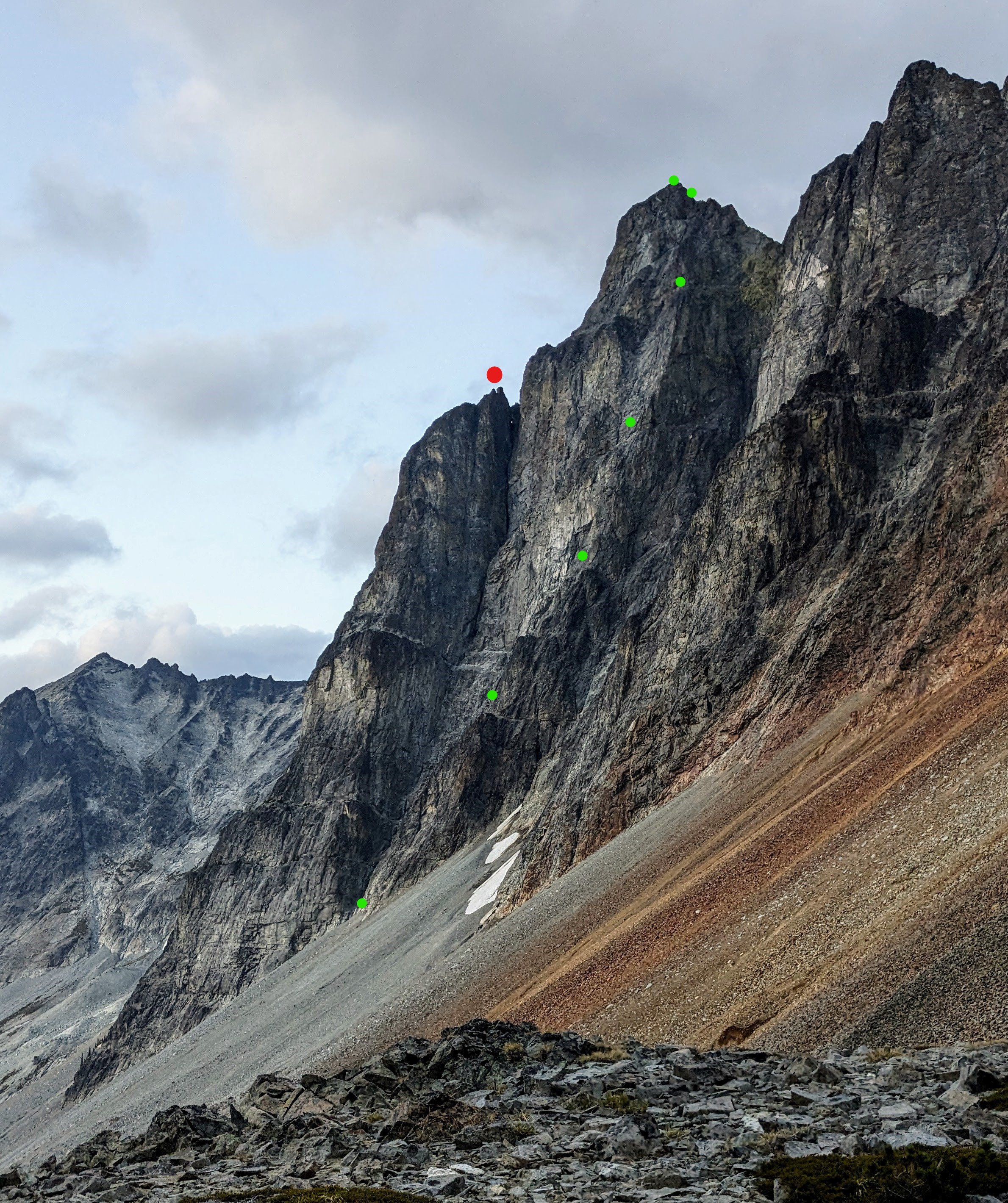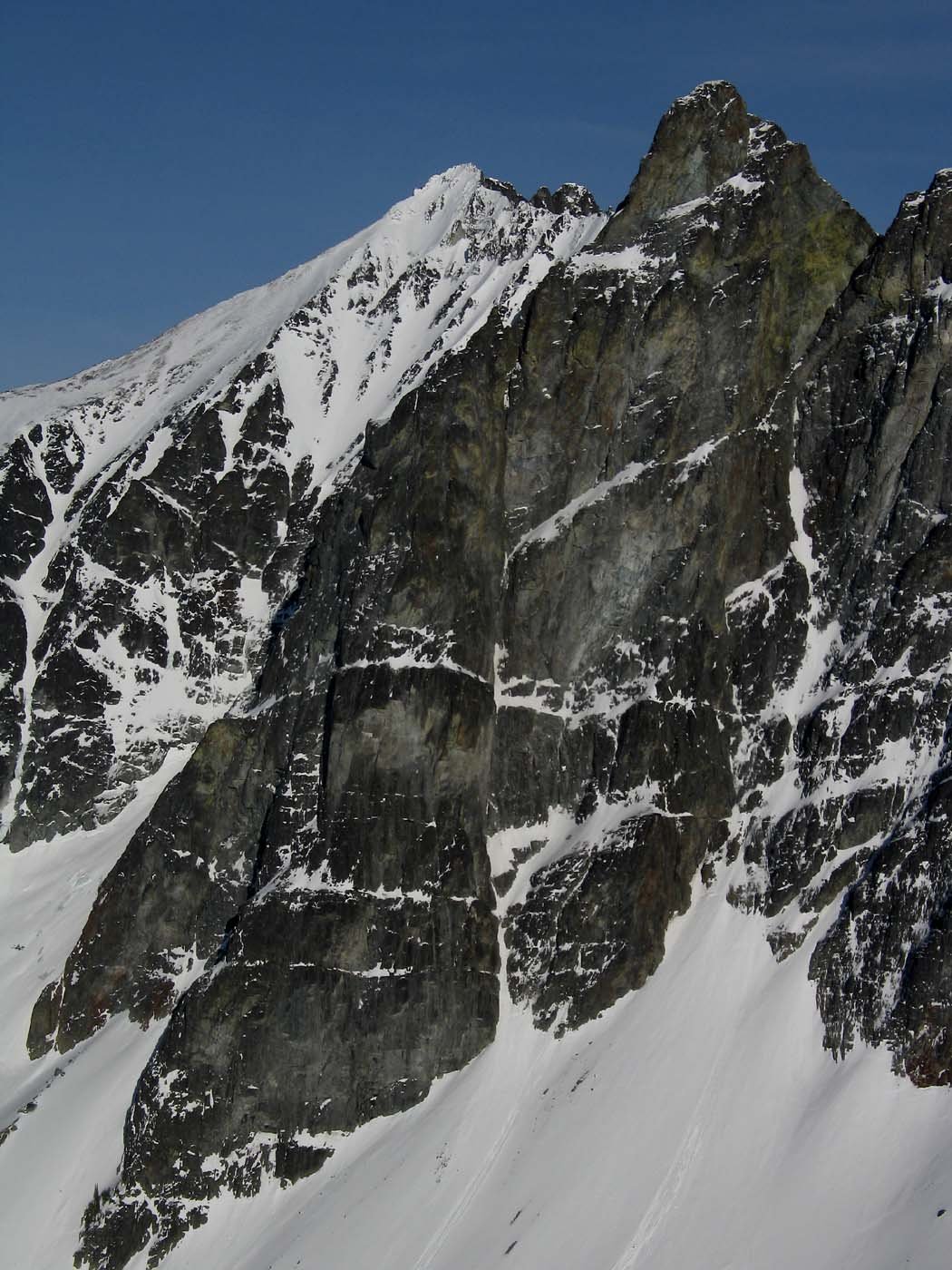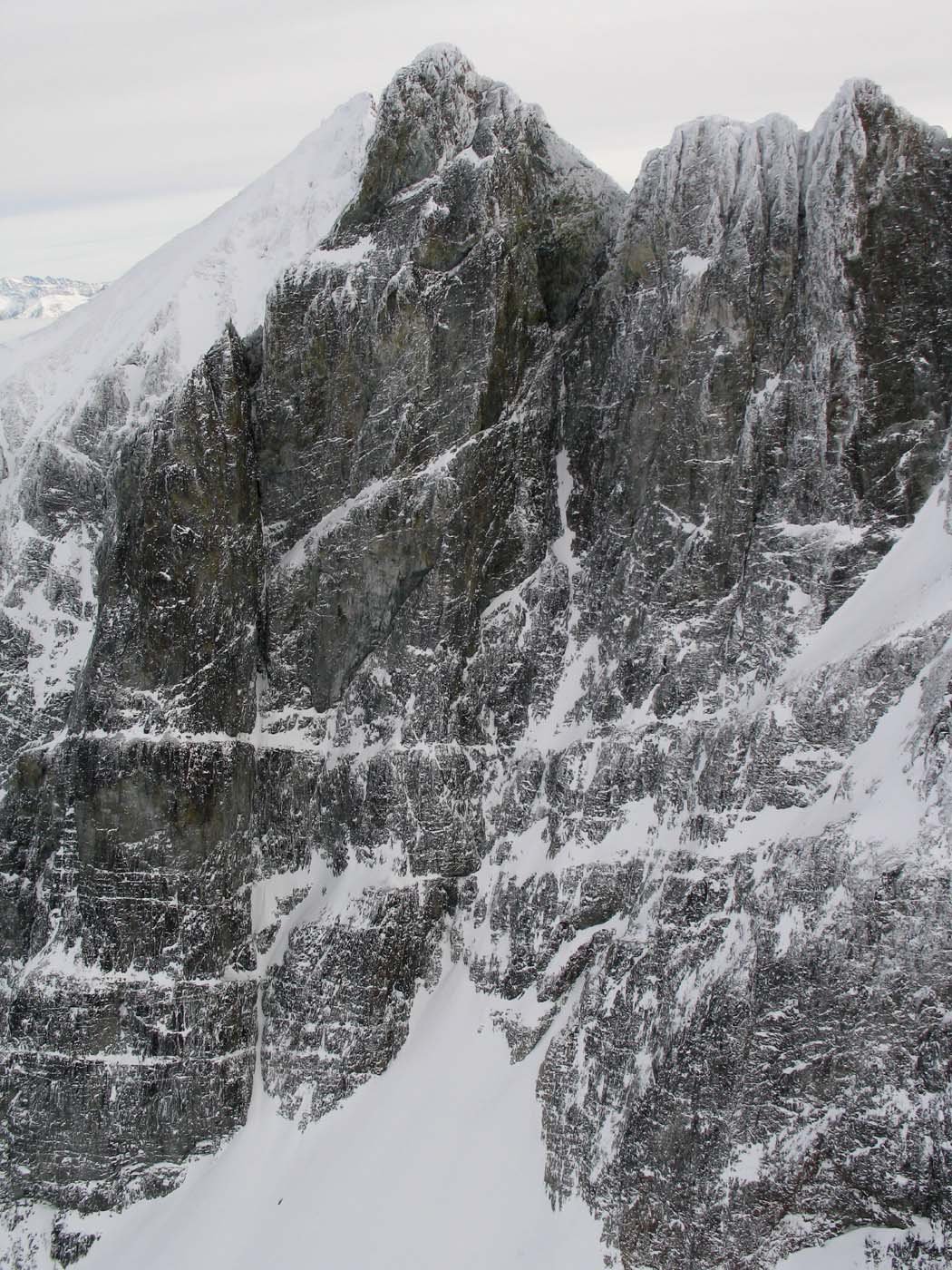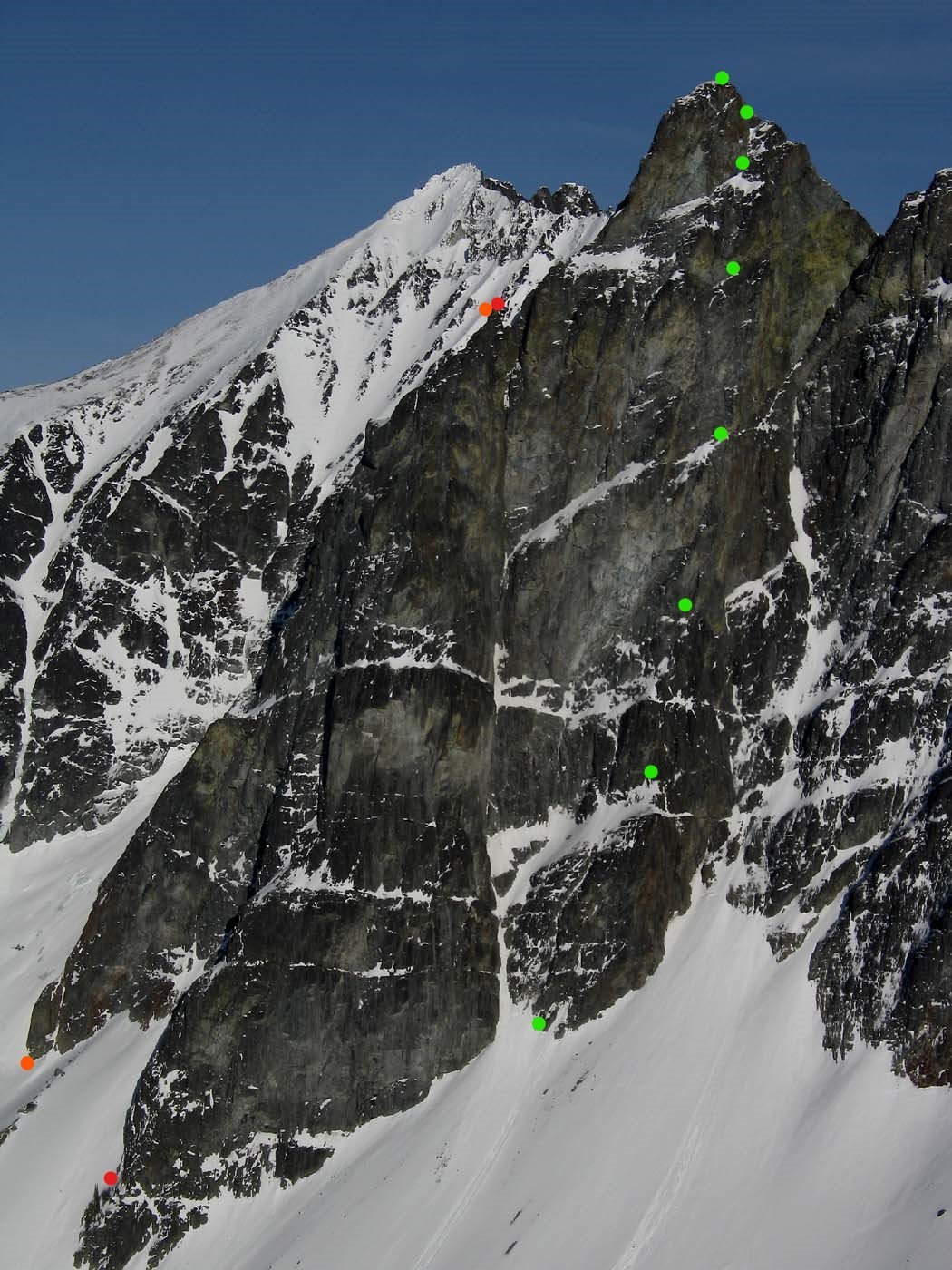-
Posts
459 -
Joined
-
Last visited
-
Days Won
17
lunger last won the day on October 18
lunger had the most liked content!
About lunger
- Birthday 12/31/1899
Converted
-
Homepage
https://get.google.com/albumarchive/108396299106837023930
-
Occupation
prof
-
Location
b'ham
Recent Profile Visitors
4760 profile views
lunger's Achievements
-
Trip: Diptop Peak - South face/rib route - FA - 1,000’, 5.8 Trip Date: 09/27/2025 Trip Report: The complex south (or perhaps SSW) face of Diptop, Jason Hummel photo: “Not too bad for a couple of old guys.” “Not too good either.” The statement and its rejoinder were uttered upon arrival at the truck -- just after dark -- and ended 14 hours of moving, including pioneering a route up (with benefit of hindsight) a questionable objective. Apparently one person’s idea of a good time is another’s idea of a bad time. The exchange echoed an earlier sentiment: “One person’s inspiration is another person's embarrassment”. Diptop is just north of Mt Daniel, and just south of the insta-famous Jade Lake. Rolf sketched our approx route below, fairly borrowed from a Wikipedia image (in turn apparently derived from a pic by Martin Bravenboer): Our "meandering-like-a-drunk" route gained 1,000 vertical feet, and entailed 6 roped pitches (the last one v. short) and a fair bit of soloing. Photos from afar inspired hope that 1. we’d be climbing on granite, and 2. there would be appealing lines on the central buttress of the expansive south face, or on the face itself. Upon closer inspection: 1. the rock was granitic, but one might say it has exfoliated "in an unfriendly manner for free climbing." And 2., while there were cracks and attractive features, it was difficult to ascertain if the seemingly discontinuous lines could be joined. We leave that to more competent and/or bolder parties to figure out. The route was reasonably solid for the alpine, and had its moments of fun. It was mostly scrambling, though it had some contrived steeper climbing and some required steeper climbing. Rolf drew the short final bit -- arguably the crux -- to the ridge crest, not far from the summit. On some of the best rock of the route, although with limited pro, he made a couple of sporty moves with a Vlad-the-Impaler flake threatening his nethers: Despite a "limited alpine skill set", perhaps indeed an “ordinary person accomplishing extraordinary things” is possible, if by extraordinary the speaker meant finding an ignominious way up a fractured granitic face. Maybe they were just “projecting insecurities", since this venture was their pet project. We might have been mildly disappointed with the route, but random insults like “twee”, “cloying”, “piker”, and various vitriolic un-printables kept the mood light. And the surroundings weren’t half bad. A couple more photos below. First roped pitch, after several hundred feet of soloing up to 5th class: Relatively high on the route: An oblique look at the central buttress from the summit area: We approached from the Tonga Ridge/Deception Cr cutoff trailhead. This much shorter approach from the north (vs coming from the south) does require travel up/down some steep timber, duff, and a bit of brush, but offers scenery, solitude (until arrival at Marmot and Jade Lakes), and berries. A little off the optimum route on the last steep stretch of the return, while monkey-bar-jungle-gyming from tree to tree down pine-needle covered duff, someone might have mumbled “we can always rap”. I’m happy to share our approximate track if you’re interested in approaching the scenic lakes without the trail slog. More photos here: https://photos.app.goo.gl/H1e1ExQ1PTVEohUE8 And more about the rock in the area here (courtesy of Rolf: https://bluemarbleearth.wordpress.com/2024/09/16/tuck-lake-and-jade-lake-geology/ Gear Notes: Took a standard double rack, but a single would do. Approach Notes: See above. To access the south face, wander down from Diptop Gap.
-
"Route 66" V 5.10 AI2 FA on the NE face of Johannesburg
lunger replied to Sam Boyce's topic in North Cascades
Nice write-up, Sam. Overcoming the myriad challenges with you two sure was fun. Being up on that wall made me feel small. Reflecting on climbing this and Little J-berg the same summer, a couple things come to mind: 1. the latter's name is apt; and 2. I think I should seek help. -
[TR] Despair (south peak) - East / SE side 09/12/2025
lunger replied to JonParker's topic in North Cascades
Agree, purty pics, thanks for posting! Sounds like your gamble to not pack the pointy bits paid off. Your TR evokes good memories of that beautiful area -- have been back there a couple of times, and agree that in the summer the Thornton Lakes --> Triumph Pass part of the approach qualifies as tedious. The pilgrim pays the price... -
Thanks for the clarification, John @John_Roper -- I've seen it variously referred to with the -burg, the -berg, the full name with either an e or a u, and sometimes the hyphenate J-. Presumably the playful J-berg is truncated to make clear it's a smaller version of the real deal, and refers to a mountain and not a city? Anyway, now we know, J-berg! Fixed it in the title, etc.
-
Trip: North Cascades, Arches Peak aka Little J-berg - North Face Central Buttress, 10 pitches plus soloing, ~1,600 vertical feet, 5.6/7ish Trip Date: 08/03/2025 Trip Report: A couple of weeks ago, Rolf Larson and I climbed a probable* new route on this peak. Anyone cresting Easy Pass has been greeted by the big north face of this peak. There is one reported route on the face from the late 1970s; the party climbed the left-hand "Plumb Line Buttress" 2,700' from the valley floor to the summit, which clocks in at 7,945'. They reported loose rock. (See photo of register page in the album linked below, the AAJ, or Beckey guide.) Of three relatively prominent buttresses, our route climbs to the western false summit (circa 200' west of true summit) via the central buttress -- the most prominent one lit up (furthest left) in the photo below. We believe the 1977 line appears in this photo as a nondescript buttress in the shade further off to the left. Our route wends up the gneissly-featured buttress on pretty good, pretty clean Skagit rock--we began climbing behind the third snow-patch from the right on that prominent shelf, directly below the toe of the sunlit buttress. (Also available here: https://photos.app.goo.gl/BV3itCHmqcoo7qL38) We had fun on this route, which thankfully was in shade while we climbed. Didn't take many climbing photos, but snippets of conversation went like this: "How'd you like that section of hand crack?" "I preferred my section of laser-cut finger crack." "Yeah, I went Squamish style and laid it back." Here's Rolf putting in a piece at perhaps mid-height on the face (the rope is out of view, off to the right): The first pitch was probably the steepest and most sustained, fwiw, and had a 5.6 or maybe .7 move. A couple of steep mini-headwalls were also climbed in that range of difficulty, but a person could avoid these if willing to take looser rock. We unroped for a few hundred feet of mellow scrambling after the first pitch or two, but some steeper terrain compelled us to again rope up and resort to pitching and simul-climbing on fourth and low-fifth terrain. The climbing is moderate, but generally solid and fun, with adequate protection. *As you will see in the summit register pics, Roger Jung soloed a route on the north face, but it's hard to say if he took our route -- there is certainly latitude to wander on that big north face. The photo album, which includes some pages from the register: https://photos.app.goo.gl/4JU83LgK6XKFdbSA7 We descended via a walk off to the south and east--no crampons required. The short-ish approach, moderate and generally solid climbing, and straightforward descent (not to mention the blueberries!!) might make this climb more appealing than some of Rolf's and my other routes. I'll wait for Rolf to correct me on any details (which are already fuzzy), downgrade the level of difficulty (as is his crusty wont), etc. etc. Here's an early musing about Arches from the cc.com archives: Gear Notes: Standard rack with emphasis in finger-sized pieces; tri-cams were useful Approach Notes: Via Easy Pass, drop to and cross Fisher Creek, find your way up through the lower cliff bands, wiggle-chimney between moat and rock to the start
- 14 replies
-
- 11
-

-

-

-

-
first ascent "Imperfect Bypass" IV 5.10+R FA of the SW ridge of Whatcom Peak
lunger replied to Sam Boyce's topic in North Cascades
Way to go you two! Each time passing by there, I have wondered about climbing straight up from that spot. Thanks for the illumination, glad you got it done. And Sam, that perspective is valuable in our home range--exploration and freedom are the primary drivers, but you gotta stomach some bad with the good. -
Thanks @SethKL! I recall being inspired by your Oregonian report, and kudos for the human-powered multi-sport approach, the long way. Yeah, coined "meat rain" not too long ago, while bouldering at the gym, of all places--some intrepid punter traversed below me into meat's air space, and needed a warning re: probability of meat showers. Not sure why the phrase erupted on that spot. Checking back on your trip report, I noticed you said something about an accident on the Soviet Route--do you have a link handy, say to an AAJ article? (Forgive my inferior search skills.) As you mentioned, worth emphasizing to future parties: be aware that there is some nice rock to keep you going, but def choss management too. Beautiful spot for adventure though.
-
Thanks, all! For location convenience, below is some background info. on the two grade V's to the north of our route. Above, I referred to these both as climbing the NW Buttress, as they climb a vaguely wishbone-like buttress that trends WNW. However, the original Soviet party called their route the North Face, and third ascent party, the West Buttress. The Oregonians characterized their line as on the NW Buttress, which I think is a reasonable reference for the entire buttress. Excerpt from the Oregonian's trip report: SW Bonanza Peak (right) and West Bonanza Peak (left) seen from the west. (Photo: Steph Abegg) 1. NW Buttress, “The Oregonian Route.” 5.9+ V. Keena and Bonnett 2013. 2. W Buttress, "The Soviet Route." 5.9+/5.10 V. Bershov et. al. 1975. (Overlay as documented by 3rd ascent party) Our route, the Cascadian, ascends the West Face off to looker's right of these two routes, topping out just right of the summit. Our first pitch begins at the small caret-shaped (^) snowfield in the pic. Here's Steph Abegg's well-researched and documented account of a third ascent of the Soviet Route, including some interesting route history: https://sites.google.com/stephabegg.com/washington/tripreports/bonanza She rightly characterizes the wall as "rival in size and difficulty to many of the biggest faces in the Cascades". This route felt reminiscent of the routes @rat and I climbed on the Hozomeens, but with a better kind of rock-quality variability, and much easier access. It has my qualified recommendation, fwiw. Here's the view of Bonanza's west wall a couple years ago en route to (or from?) Dark Peak. The Cascadian ascends slightly left of center (begins just right of the tiny snowpatch), the other routes begin out of view at far left margin. The portion of the wall to the right, above the long snowfield, is unclimbed and looks positively atrocioulicious.
-
Trip: Bonanza Peak's Southwest Summit, West Face - Cascadian Route V 5.10+ Trip Date: 08/26/2023 Here's a couple obligatory John Scurlock photos of the western aspect of Bonanza's Southwest Summit: Trip Report: Summary: Sam Boyce and I took a 3-day weekend to climb a new route* on the West Face of Bonanza’s SW Summit. The Cascadian Route (V 5.10+) ascends Bonanza’s intimidating western wall. Our line gains >2,000 vertical feet over 16 pitches and 2,800’ of climbing. For context, our route is off to looker’s right of its neighbors to the north, the Soviet Route (1976) and the Oregonian Route (2013), both of which ascend the Northwest Buttress (previously also referred to as the "West Buttress", and in 1976 "the North Face") of the SW summit. In a marked up version of Sam's photo below: The approx. Cascadian route in green (each dot approx 3 pitches); the Soviet and Oregonian routes off to the left meet near the 8,700’ subsummit pinnacle on the skyline (red point), before ascending mellower terrain on the peak’s more-northern aspect (out of view; parties apparently traversed left under red roofs of the summit block): On the Scurlock photo, same color scheme (Soviet red, Cascadian green), but with the Oregonian start indicated by an orange dot: From the 9,320’ summit, we descended the Isella Glacier, which (as can be seen on satellite imagery) is split at approx. mid-height by a magically continuous undulating walkway. We were able to walk and downclimb (one low-fifth crux) to roughly 6,900’ without rappelling or touching snow, then used a notch/gully to drop through the peak’s south ridge before circling back up to our 7,000’ camp near the North Star – Bonanza col. Near the col above the bivy, there remains a small snow patch that provides water, even near the end of this hot dry 2023 summer. Report: Several years ago en route to climb Dark Peak with my friend Jon, we crossed (interminable and uniquely annoying scree) under Bonanza’s SW summit and gaped up at the expanse of rock on its western flank. I made a mental note to explore new routes if given the right conditions. Thanks to Sam’s can-do attitude and vision, and the forecasted wildfire smoke that ruled out other candidates, this was the moment. On Friday 25 Aug we made the time-consuming approach (car, Chelan-Lucerne ferry, Holden bus transport, many miles of walking); Saturday we finished the approach, climbed and descended to camp (15 hours, dawn to dusk); and early Sunday boogied out to catch the 10am Holden to Lucerne bus, then ferry, etc., etc. Would you believe the route looked this good all the way up? (Above: Sam follows the pleasurable 5.10a pitch 8, sends a sweet 5.10 corner on pitch 9, and earns his kale on the 5.10+ pitch 13 overhang) That would be a mistake: (Above: Eric confronts the heinous choss band of 5.8+ pitch 4, and the tricky steep delights of 5.10R pitch 12) While there were enjoyable stretches, there were also satiating portions of choss. Roof systems, particularly a large one that spans the west face feature near the top, provided few weaknesses and narrowed free-climbing line options to 1 or maybe 2 in places. We were both concerned about passage near the top, as bailing would be fraught and difficult. The technical highlights were five pitches of 5.10; three of these (pitches 8, 9 & 13) sported steep and fun climbing, but another two (pitches 11 & 12) were horsepuckey. For much of the climbing on these two steep 5.10R puckery pitches, literally not a single hold was loose; nah, haha, two or more were. While the featured rock inspired a kind of upward hope, protection was occasional, creative, and even whimsical—bring your bag of tricks. These pitches offered quality terror-tainment (@rat ©). This was a no meat-rain zone. The rest of the route predominantly ranged from mid-fifth to 5.8 on similarly varying rock quality—any given hold might be probably portable, or revealed as a solid protrusion of the mountain, eternally nonmoving and crank-able. Climbing of this sort can be extremely engaging and stimulating, and while Sam and I enjoyed moving up the route, it might not be to others’ tastes. For interested folks, he took concise notes on the pitches, and will hopefully chime in here with that info. * I encountered a 2.5” Trango Flex-Cam in a crack with a ‘biner attached on pitch 4, after the first heinous choss band but before the most technical climbing. This late-‘90s/early-aughts era cam was in a textbook placement and easily removed. The sling is weathered, perhaps had been sitting there for 10-20 years (hard tellin'). Anyway, given no evidence of passage in the pitches above, we surmise that perhaps this was used for bailing. A search for attempts or climbs of this feature has not borne fruit. However, if anyone knows better, please advise. Here are a few more photos. They don’t really do the route’s position and exposure justice, but they do serve to highlight the area’s rock/choss quality variability. (Above: choose your own adventure, then call your mom) (Above: In a move that typifies much of the climbing, Sam stems out in search of better rock) (Above: Eric following the overhanging section of 5.10+ on pitch 13) Here's an album with more pics, including descent: https://photos.app.goo.gl/8qAiXj6o4BfRSGJm9 Gear Notes: Lots of small gear was helpful, a bag of tricks (ball nuts, tricams) useful, and we also used some pins at belays. No need really for anything larger than a #3. 70m rope. Approach Notes: There are many ways to get there, but we took arguably the easiest starting via the ferry to Lucerne. Good bivy sites just south of the North Star – Bonanza col, around 7,000'
-
Probably prime season for this line right now. Thanks mostly to Darin, it's quite clean and goes to a cool summit--we climbed it again earlier this month, and imho it's worth repeated trips (plus there's a .10- variation). here's Darin's detailed mtn project page for the route: https://www.mountainproject.com/route/124480260/salad-days folks should get on this and keep it clean!

